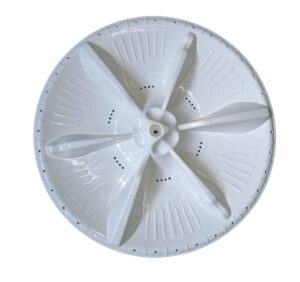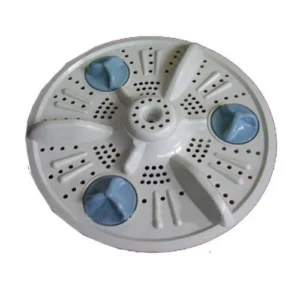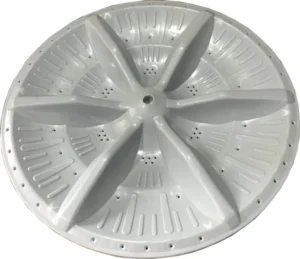Washing Machine Pulsator:
A washing machine pulsator is a fundamental component of many top-loading washing machines that plays a crucial role in the washing process. This device, which is often misunderstood or overlooked by consumers, is responsible for creating the unique washing action that cleans your clothes effectively while being gentler on them compared to traditional agitators. In this comprehensive discussion, we will delve into the concept of a pulsator for washing machines, its design, functions, benefits, and its role in modern laundry appliances.
Introduction(washing machine pulsator)
A washing machine pulsator, also known as an impeller, is a specialized mechanism found in top-loading washing machines, which are commonly used in households worldwide. Unlike front-loading machines, which use a horizontal drum and a tumbling action, top-loading machines utilize a vertical drum and rely on the pulsator’s motion to agitate the clothes during the washing cycle.
Design and Types of Washing Machine Pulsator:
Washing Machine Pulsator come in various designs, with each type offering slightly different washing motions. The primary designs include:
- Single-Wing Pulsator: This design has a single wing or fin extending from the center of the pulsator. As the drum rotates, the wing generates a back-and-forth pulsating motion, creating water turbulence and gently moving the clothes.
- Dual-Wing Pulsator: The dual-wing pulsator has two wings opposite each other. This design produces a more dynamic pulsating motion, effectively loosening dirt and stains from fabrics. The counter-rotating wings provide a superior cleaning action.
- Multiple-Wing Pulsator: Some advanced washing machines feature pulsators with multiple wings, creating even more complex washing motions. These are often found in high-end models.
- Drum-Type Pulsator: Instead of separate fins or wings, this design incorporates fins directly into the drum’s interior. As the drum rotates, these built-in fins generate the pulsating action, which is known for its gentle yet effective cleaning.
The choice of pulsator design can influence the washing machine’s performance and cleaning efficiency. Manufacturers select the appropriate design based on factors such as the machine’s intended use, capacity, and cost considerations.
Function of Washing Machine Pulsator
The primary functions of a pulsator in a washing machine include:
- Agitation: The core purpose of a washing machine pulsator is to agitate the water and clothes within the drum. Its unique motion generates turbulent water flow, helping dislodge dirt and stains from the fabric. This agitation is essential for a thorough and effective cleaning process.
- Gentle Washing: Pulsators are designed to provide a gentler washing action compared to traditional agitators. This makes them ideal for washing delicate fabrics and clothing items that could be damaged by the harsh mechanical action of an agitator. The pulsator’s movement is more akin to a gentle massaging motion, reducing wear and tear on clothes.
- Water Efficiency: Pulsators are often more water-efficient than agitators. Their design allows for better water circulation within the drum, which means less water is required for each wash cycle. This not only conserves water but also leads to lower water bills.
- Enhanced Cleaning: The pulsating motion created by the pulsator is effective at reaching areas of the fabric that may be harder to clean with a simple agitator. This results in a more thorough and efficient cleaning process, especially for heavily soiled items.
- Load Balance: Some modern washing machines with pulsators are equipped with load-sensing technology. This feature detects the weight and distribution of the laundry load and adjusts the pulsator’s motion accordingly. By preventing imbalance, it minimise vibration during the spinning cycle, ensuring a stable and quiet operation while extending the machine’s lifespan.
Benefits of Washing Machine Pulsators:
The use of washing machine pulsators in top-loading washing machines offers several notable advantages:
- Efficient Cleaning: Pulsators create dynamic washing motions that effectively clean clothes and remove stains. The pulsating action helps ensure a thorough and even distribution of water and detergent throughout the load.
- Gentler on Fabrics: Pulsators are designed to be gentler on clothing, reducing the risk of damage or excessive wear and tear. This makes them suitable for washing delicate and more expensive fabrics.
- Water and Energy Efficiency: Pulsators’ efficient water circulation results in reduced water usage. Additionally, the gentler motion requires less energy to operate compared to traditional agitators, making them more energy-efficient.
- Quieter Operation: The absence of a central agitator means that washing machines with pulsators tend to produce less noise during operation.
- Load Sensing and Balance: Pulsator-equipped washing machines often include load-sensing technology, which not only conserves resources but also enhances machine stability and longevity by preventing imbalanced loads.
- Compact Design: Pulsators allow for a more compact design of the washing machine, which can be beneficial for homes with limited space.
Washing Machine pulsators are a significant innovation in modern laundry appliances. They are designed to meet the evolving needs of consumers who prioritize efficiency, convenience, and fabric care. Top-loading washing machines with pulsators provide an alternative to the traditional agitator-style machines and have gained popularity for their gentle yet effective cleaning process.

